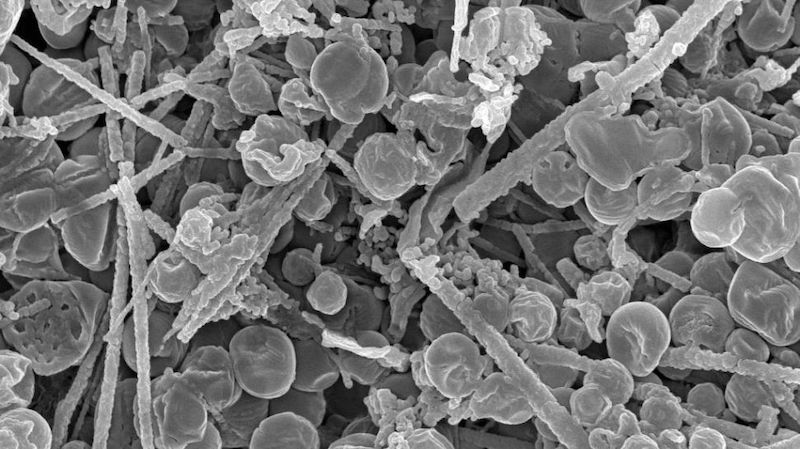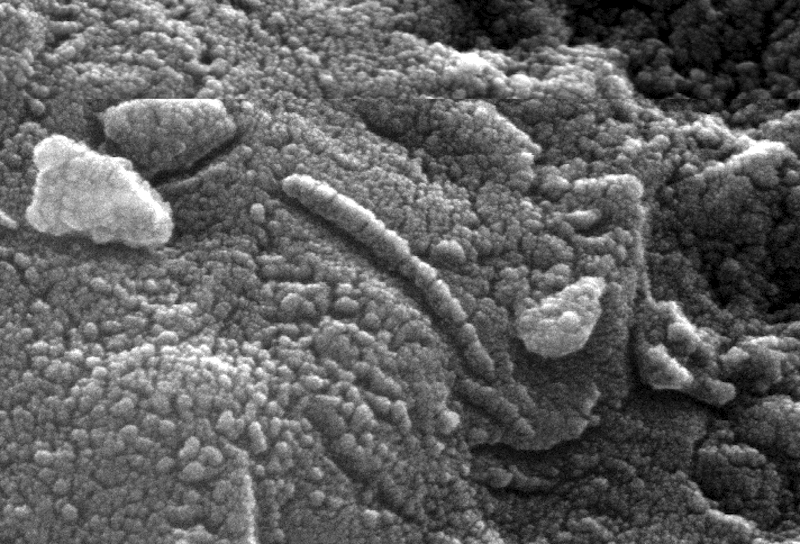
Was there ever life on Mars? That is one of the most tantalizing questions that planetary scientists are still trying to answer. For example, NASA’s Perseverance rover is currently searching for evidence of microbial fossils in an ancient lake bed. And, indeed, it might find them. But now, scientists in the U.K. are warning that false fossils could complicate that search. These are non-biological deposits in rocks that look a lot like fossils from microbial critters, but actually aren’t.
The researchers published their new peer-reviewed paper in the Journal of the Geological Society on November 17, 2021.
EarthSky 2022 lunar calendars now available! They make great gifts. Order now. Going fast!
Dozens of false positives
The problem, the researchers say, is that many chemical and non-biological formations can mimic biological ones. Dozens of such processes have now been identified that could do this in the Martian environment. Some of them can resemble cells and the building blocks of life. As Julie Cosmidis, a geobiologist at the University of Oxford in England, commented in an article last week in LiveScience:
There is a real chance that one day, we will observe something on Mars that looks really biological, only to realize several years later, after further research, that this thing was actually formed by nonbiological processes. There is a wide diversity of potential false biosignatures on Mars.

In the University of Edinburgh press release, she also noted:
We have been fooled by life-mimicking processes in the past. On many occasions, objects that looked like fossil microbes were described in ancient rocks on Earth and even in meteorites from Mars, but after deeper examination they turned out to have non-biological origins. This article is a cautionary tale in which we call for further research on life-mimicking processes in the context of Mars, so that we avoid falling into the same traps over and over again.
A fossil is not always a fossil
Just because something looks like a fossil, doesn’t mean it always is. Sean McMahon, an astrobiologist at the University of Edinburgh in Scotland and lead author of the new study, said:
At some stage a Mars rover will almost certainly find something that looks a lot like a fossil, so being able to confidently distinguish these from structures and substances made by chemical reactions is vital. For every type of fossil out there, there is at least one non-biological process that creates very similar things, so there is a real need to improve our understanding of how these form.
The range of structures, materials and chemical compositions that can be produced nonbiologically overlaps quite closely with the range of things that can be produced biologically. Some phenomena have been debated for decades, and we’re still not sure if they’re biological or not.

Cosmidis added:
The problem is that these false biosignatures are often disproved only after further analysis by different researchers, using different techniques. But for Mars, we won’t have this option until years after the samples get collected.
Different kinds of false fossils on Mars
One possible false fossil is a carbon-sulfur biomorph. These tiny spheres are similar in size to bacteria and can form spontaneously from reactions between carbon and sulfide. According to Cosmidis:
If one day we find microscopic organic filaments and spheres in Martian rocks, it will be very tempting to interpret them as fossil bacteria, but they could very well just be carbon-sulfur biomorphs.
There are also pseudo-microbialites, which mimic the physical structures created by microbes, such as stromatolites. On Earth, stromatolites are created by photosynthetic organisms such as algae, and form domes, cones and columns. However, pseudo-microbialites also resemble these structures. Therefore, detailed analysis would be needed to determine the true origin of such formations on Mars.
These kinds of formations occur through chemicals mixing in chemical gardens.

Weathering and the depositing of sedimentary layers can also produce rocks that look just like fossils. Textures on rocks can also sometimes look biological. Surprisingly, even isotope ratios of various elements can appear similar to isotope ratios in biological contexts.
Avoiding a premature announcement
The researchers’ primary goal in this study is to try to prevent a future erroneous announcement of the discovery of life being made. The discovery of life on Mars would be one of the most important and exciting in all of scientific history. It is imperative, therefore, that such an announcement would not be made prematurely, before the science can fully support it. As Cosmidis noted:
These errors and their corrections are a normal process in science. But on a topic that is receiving as much attention from the public as the search for life on Mars, there is a risk that they could generate public mistrust in scientists.
We are not trying to dismiss all the efforts that NASA and ESA are currently putting into finding traces of life on Mars. We want to support these efforts by helping the researchers involved in these missions make better and more informed interpretations of the objects they will observe.

Allan Hills 84001
Probably the most famous example of such a declaration was the one in 1996. Scientists said they had discovered evidence of ancient microbial life in a Martian meteorite called Allan Hills 84001. President Clinton even announced it as a historic discovery.
Decades later, the results are still being debated, although the consensus now is that the fossilized bacteria-like objects were probably created by non-biological processes.
In 2019, scientists announced that putative Martian fossils had also been discovered in the Martian meteorite ALH-77005. These were mineralized and filament-like organic material.
The search for life on Mars is entering an exciting new phase. This new study, however, provides a cautionary tale. Things aren’t always as they first appear. But if new evidence of ancient microbial life is found, and is ultimately confirmed, it will be well worth the wait.
Bottom line: A new study from scientists in the U.K. says that false fossils on Mars could complicate the search for ancient microbial life. These pseudo-fossils could be mistaken for real fossils. Scientists want to avoid an erroneous premature declaration of the discovery of life.
Source: False biosignatures on Mars: anticipating ambiguity
Via the University of Edinburgh
The post False fossils on Mars might inhibit search for life first appeared on EarthSky.
from EarthSky https://ift.tt/3lWIaPt

Was there ever life on Mars? That is one of the most tantalizing questions that planetary scientists are still trying to answer. For example, NASA’s Perseverance rover is currently searching for evidence of microbial fossils in an ancient lake bed. And, indeed, it might find them. But now, scientists in the U.K. are warning that false fossils could complicate that search. These are non-biological deposits in rocks that look a lot like fossils from microbial critters, but actually aren’t.
The researchers published their new peer-reviewed paper in the Journal of the Geological Society on November 17, 2021.
EarthSky 2022 lunar calendars now available! They make great gifts. Order now. Going fast!
Dozens of false positives
The problem, the researchers say, is that many chemical and non-biological formations can mimic biological ones. Dozens of such processes have now been identified that could do this in the Martian environment. Some of them can resemble cells and the building blocks of life. As Julie Cosmidis, a geobiologist at the University of Oxford in England, commented in an article last week in LiveScience:
There is a real chance that one day, we will observe something on Mars that looks really biological, only to realize several years later, after further research, that this thing was actually formed by nonbiological processes. There is a wide diversity of potential false biosignatures on Mars.

In the University of Edinburgh press release, she also noted:
We have been fooled by life-mimicking processes in the past. On many occasions, objects that looked like fossil microbes were described in ancient rocks on Earth and even in meteorites from Mars, but after deeper examination they turned out to have non-biological origins. This article is a cautionary tale in which we call for further research on life-mimicking processes in the context of Mars, so that we avoid falling into the same traps over and over again.
A fossil is not always a fossil
Just because something looks like a fossil, doesn’t mean it always is. Sean McMahon, an astrobiologist at the University of Edinburgh in Scotland and lead author of the new study, said:
At some stage a Mars rover will almost certainly find something that looks a lot like a fossil, so being able to confidently distinguish these from structures and substances made by chemical reactions is vital. For every type of fossil out there, there is at least one non-biological process that creates very similar things, so there is a real need to improve our understanding of how these form.
The range of structures, materials and chemical compositions that can be produced nonbiologically overlaps quite closely with the range of things that can be produced biologically. Some phenomena have been debated for decades, and we’re still not sure if they’re biological or not.

Cosmidis added:
The problem is that these false biosignatures are often disproved only after further analysis by different researchers, using different techniques. But for Mars, we won’t have this option until years after the samples get collected.
Different kinds of false fossils on Mars
One possible false fossil is a carbon-sulfur biomorph. These tiny spheres are similar in size to bacteria and can form spontaneously from reactions between carbon and sulfide. According to Cosmidis:
If one day we find microscopic organic filaments and spheres in Martian rocks, it will be very tempting to interpret them as fossil bacteria, but they could very well just be carbon-sulfur biomorphs.
There are also pseudo-microbialites, which mimic the physical structures created by microbes, such as stromatolites. On Earth, stromatolites are created by photosynthetic organisms such as algae, and form domes, cones and columns. However, pseudo-microbialites also resemble these structures. Therefore, detailed analysis would be needed to determine the true origin of such formations on Mars.
These kinds of formations occur through chemicals mixing in chemical gardens.

Weathering and the depositing of sedimentary layers can also produce rocks that look just like fossils. Textures on rocks can also sometimes look biological. Surprisingly, even isotope ratios of various elements can appear similar to isotope ratios in biological contexts.
Avoiding a premature announcement
The researchers’ primary goal in this study is to try to prevent a future erroneous announcement of the discovery of life being made. The discovery of life on Mars would be one of the most important and exciting in all of scientific history. It is imperative, therefore, that such an announcement would not be made prematurely, before the science can fully support it. As Cosmidis noted:
These errors and their corrections are a normal process in science. But on a topic that is receiving as much attention from the public as the search for life on Mars, there is a risk that they could generate public mistrust in scientists.
We are not trying to dismiss all the efforts that NASA and ESA are currently putting into finding traces of life on Mars. We want to support these efforts by helping the researchers involved in these missions make better and more informed interpretations of the objects they will observe.

Allan Hills 84001
Probably the most famous example of such a declaration was the one in 1996. Scientists said they had discovered evidence of ancient microbial life in a Martian meteorite called Allan Hills 84001. President Clinton even announced it as a historic discovery.
Decades later, the results are still being debated, although the consensus now is that the fossilized bacteria-like objects were probably created by non-biological processes.
In 2019, scientists announced that putative Martian fossils had also been discovered in the Martian meteorite ALH-77005. These were mineralized and filament-like organic material.
The search for life on Mars is entering an exciting new phase. This new study, however, provides a cautionary tale. Things aren’t always as they first appear. But if new evidence of ancient microbial life is found, and is ultimately confirmed, it will be well worth the wait.
Bottom line: A new study from scientists in the U.K. says that false fossils on Mars could complicate the search for ancient microbial life. These pseudo-fossils could be mistaken for real fossils. Scientists want to avoid an erroneous premature declaration of the discovery of life.
Source: False biosignatures on Mars: anticipating ambiguity
Via the University of Edinburgh
The post False fossils on Mars might inhibit search for life first appeared on EarthSky.
from EarthSky https://ift.tt/3lWIaPt

Aucun commentaire:
Enregistrer un commentaire